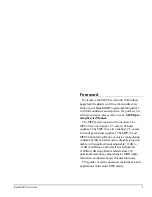
7
Rane MPE Users Guide
lower frequency bands (31.5-630 Hz) of the
equalizer. Pressing EQ again selects the upper
frequency bands (800-16 kHz). Pressing EQ a
third time returns you to Normal Operating mode.
The LED corresponding to the group of bands
you choose illuminates, and a cursor flashes in
the EQUALIZER display.
2. Select a band or overall level by pressing its key
(31.5-16k , or LEVEL ). The LED associated with
this parameter lights. The parameters current
value appears in the EQUALIZER display.
3. Press the UP or DOWN key to boost or cut the
selected parameter.
4. Repeat steps 1-3 until all changes are complete.
5. Press STORE to enter the Store function and
save your changes, or EQ to return to Normal
Operating mode. If you chose to store your new
parameters, skip down to the Storing Working
Memory section for further instructions.
Once a curve has been altered, the MEMORY
LED flashes indicating that Working Memory no
longer matches the Stored Memory shown in the
SYSTEM display. This is your cue to store these
changes before recalling a new Stored Memory (in
which case the Working Memory parameters are
overwritten and lost if not stored somewhere).
There are two additional user functions that you
can invoke while editing the equalizer parameters.
These are compare and clear.
Comparing Working Memory To Stored
M e m o r y
You can always compare two Stored Memories
when you’re in the Normal Operating mode simply
by recalling them to Working Memory and listening
to the difference. If they are two consecutive memo-
ries, then the UP and DOWN keys are all that is
required. Otherwise you have to type in their numbers.
While you are in the EQ Edit mode, you can
audibly compare the contents of Working Memory
to the Stored Memory shown in the SYSTEM
display. This allows you to perform A-B compari-
sons between the original and altered curves.
To activate the compare function, press and hold
the MEMORY key while in the EQ Edit mode. You
now hear the contents of the Stored Memory. A
letter “
C
C
” occupies the EQUALIZER display
verifying the compare function.
When you release the MEMORY key, Working
Memory returns to the equalizer. You can compare
anytime during the edit process.
Operating The Clear Command
Simultaneously pressing the UP and DOWN keys
while in the EQ Edit mode clears the parameter
under edit to 0dB. If you haven’t chosen a band or
overall level (i.e., you haven’t implemented step 2 of
the above editing instructions) the entire Channel is
cleared.
Once the clear command is activated, a
0
0
appears
in the EQUALIZER display and the LED(s) corre-
sponding to the affected parameter(s) turns on for
one second to verify the operation.
Storing Working Memory
Now that you’ve recalled a curve and changed it,
you will want to save it. This is accomplished with
the Store function.
The Store function transfers the parameters in
Working Memory to a specified Stored Memory.
Once the transfer is complete, you are returned to
Normal Operating mode.
Here is the play-by-play action:
1. Press STORE to enter the Store function. (You
may have already done this, as instructed in the
editing instructions above.) Once you are in the
Store function, the SYSTEM display flashes with
the default (current) Stored Memory location.
2. Enter a different Stored Memory number, if
desired, using the number keys. The SYSTEM
display will continue to flash. You can also use
UP or DOWN to scroll through Stored Memory
numbers.
3. Once you’ve selected the proper Stored Memory
number, press STORE again to complete the
transfer and return to Normal Operating mode. If
you change your mind, press MEMORY to
return to Normal Operating mode without storing.
The SYSTEM display stops flashing.
Hey—guess what? You now know everything
there is to know about recalling a curve, changing it,
and sending it to a Stored Memory. Congratulations.
Take some time out to practice this for awhile, and
then we will resume our discussion with some more
advanced user operations…
Summary of Contents for MPE series
Page 21: ...21 Rane MPE Users Guide...








































